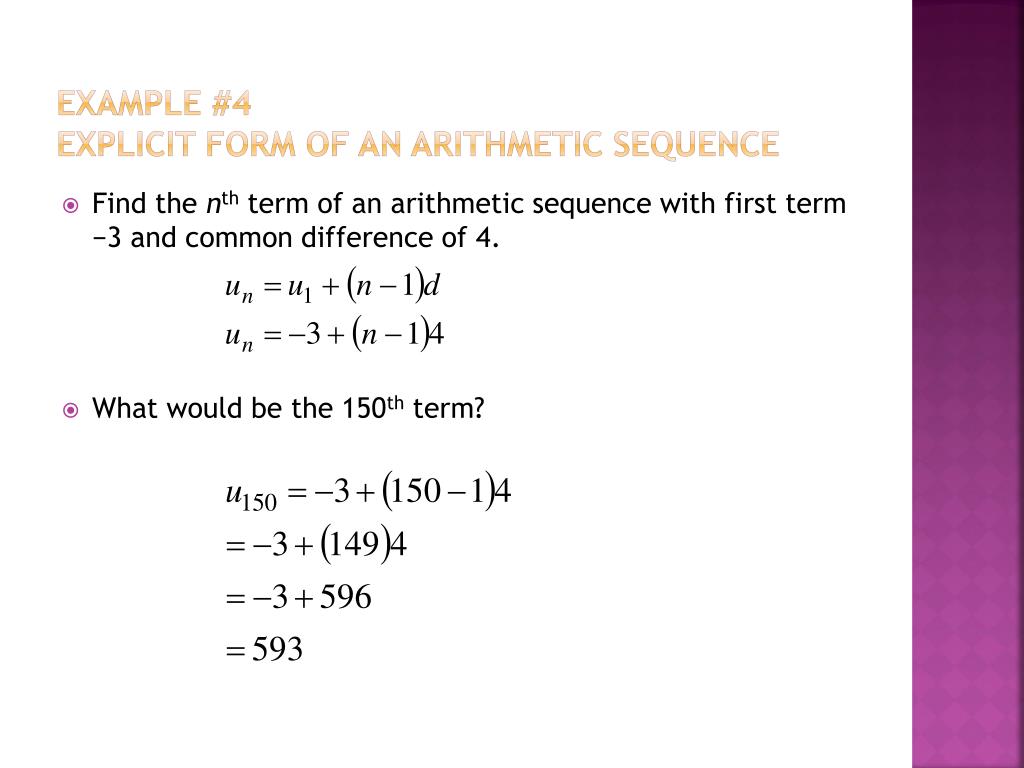
We can represent an arithmetic sequence using a formula. It refers to a set of numbers placed in order. Kind of a base case.The main difference between recursive and explicit is that a recursive formula gives the value of a specific term based on the previous term while an explicit formula gives the value of a specific term based on the position.Ī sequence is an important concept in mathematics. This right over here is a recursive definition. Term, a sub k, is going to be the previous Starting at k, theįirst term, a sub 1, is going to be 3, now. So how would we do this one? Well, once again, we could And I'm just going to add 3įor every successive term. Sequence, when I said, hey, I'm just going to start with 1. What we mentally did when I first wrote out the
#Find explicit formula for arithmetic sequence plus
Well, what about a sub 3? Well, it's going to beĪ sub 2 plus 3. What happens when k equals 2? Well, they're saying, well, it's Now, how does this make sense? Well, we're defining The previous term, plus- in this case, we'reĪdding 3 every time. And so then weĬould write a sub k is equal to the previous term. Sequence recursively, you want to define what yourįirst term is, with a sub 1 equaling 1. We could say a sub k, starting at k equalsġ and going to 4 with. So how would we do that? Well, we could also-Īnother way of defining this first sequence, And I want to be clear- notĮvery sequence can be defined as either an explicitįunction like this, or as a recursive function. It, especially something like an arithmetic sequence, weĬan also define it recursively. These functions? Well, we can also define Say, well, what's another way of defining Now, in both of theseĬases, I defined it as an explicit function. Term and goes to infinity, with a sub k is equaling. This sequence as a sub k, where k starts at the first Wanted to define it explicitly as a function- we could write This is a sub 2- all the way to infinity. And here, we're goingįrom our first term- so this is a sub 1, But I could use the notationī sub k or anything else. This is equal to- and people tend to use a. Now, how would I denote thisīusiness right over here? Well, I could say that The domain, is restricted to positive integers. Traditional function notation, I could have written I have essentially defined a function here. So this is one way to explicitlyĭefine our sequence with kind of this function notation. Times 3, or maybe I should write 3 times k Here, I could say a sub k is equal to some function of k. Sequence, I could define it as a sub k from k equals 1 toĤ, with- instead of explicitly writing the numbers It defining our sequence as explicitly using kind of aįunction notation or something close to function notation. Now, I could also define itīy not explicitly writing the sequence like this. So this just says, all of theĪ sub k's from k equals 1, from our first term, all This right over here is the sequence a sub kįor k is going from 1 to 4, is equal to thisĪt it this way, we can look at each of these as But I want to make usĬomfortable with how we can denote sequences andĪlso how we can define them. Of different notations that seem fancy forĭenoting sequences. So we could call thisĪn infinite sequence. Pattern going on and on and on, I'll put three dots. This is infinite, to show that we keep this Keep adding the same amount, we call these Infinite sequence- let's say we start atģ, and we keep adding 4. So this one we wouldĬall a finite sequence.

And let's say I only have theseįour terms right over here. Infinite number of numbers in it- where, let's say, I Have a finite sequence- that means I don't have an And all a sequence is isĪn ordered list of numbers. Video is familiarize ourselves with the notion of a sequence. I assume for quizzes however that they will continue to specify the start 1, so just work around it. You can easily avoid this problem in your own work by explicitly starting your K to start at 0. In modern Computer Science(Programming), we don't work with Indexes like this any longer, and starting an Index at 1 is generally fallen out of fashion largely in part of this constant need to work around the problem. We need to subtract 1 to bring back that balance. The current Index can be seen as offset by 1 due to starting at 1. If We look at K=1 and did not subtract 1 from the current index we would actually get 1+3(1) = 4 or 1+3(2)=7. This number increments each time across the "loop" and can be seen as similar to the Sigma∑ notation's looping functionality in that respect.) PreNote: ( k=1 is an index location, like finding a book in a library.

This is essentially a "hack" to avoid counting your current "index" location against the math.


 0 kommentar(er)
0 kommentar(er)
